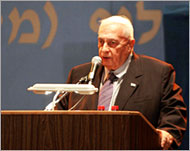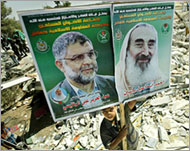Al-Aqsa intifada timeline
Palestinians marked the fifth anniversary of the al-Aqsa intifada (uprising) against Israeli occupation on Wednesday.

Here are some of the pivotal events:
28-29 September 2000
Former Israeli army general and then opposition leader Ariel Sharon visits al-Aqsa mosque with his entourage, sparking a violent reaction from Palestinians.
Israel reoccupies the Palestinian territories amid fighting between the Palestinian resistance and Israeli army.
A second intifada begins which, according to Israeli human rights organisation BTselem, kills 3315 Palestinians and 972 Israelis as of 15 September 2005.
7 March 2001
Sharon, who opposed the Oslo interim peace deal with Palestinians and statehood talks at Camp David, takes office as prime minister.
21 May 2001
Former US senator George Mitchell releases his report (the Mitchell Plan) on the Middle East conflict. It calls for a ceasefire, confidence-building measures and, ultimately, negotiations.
16 June 2002
Israel begins construction of a wall to create a barrier between it and the West Bank.
20 September 2002
Israel besieges Palestinian president Yasser Arafat’s headquarters in Ram Allah, demolishing most of his office complex and confining him there, while embarking on a policy of extra-judicial assassinations and imprisonment of Palestinian leaders.
28 January 2003
Israelis re-elect Sharon.
26 February 2003
Israel begins a series of incursions, repeated throughout the year, that lead to the reoccupation of parts of the Gaza Strip and the West Bank, inflicting widespread damage and heavy civilian casualties.
27 February 2003
 |
|
Sharon’s visit to the al-Aqsa |
Crown prince Abdullah bin Abdulaziz of Saudi Arabia announces an Arab peace initiative in the Middle East. The plan calls for Israeli withdrawal from the occupied territories in return for Arab recognition of Israel‘s right to exist. A similar version but with reservations is later adopted by the Arab League.
29-30 April 2003
After the invasion of Iraq by US-led forces, Arafat, under intense international pressure, allows the election of Mahmoud Abbas as Palestinian prime minister.
The Israelis and Palestinians receive the “road map” formula for peace, backed by the Quartet of Russia, the European Union, the United States and the United Nations.
4 June 2003
Sharon and Abbas meet at Aqaba, Jordan, to discuss the implementation of the peace road map.
25 July 2003
Abbas visits the White House, meeting US President George Bush, in a visit designed to speed the road map peace process.
6 September 2003
Abbas resigns amid a power struggle with Arafat and an upsurge in violence.
2 February 2004
Sharon announces his unilateral Gaza withdrawal plan, shocking Palestinians, the world and many members of his own Likud Party who are vehemently against giving up Jewish settlements in occupied territory.
22 March 2004
Israel assassinates wheelchair-bound Shaikh Ahmad Yassin, spiritual leader of the Palestinian resistance movement Hamas, in an air strike that also kills several civilians.
14 April 2004
Sharon presents the Gaza pullout plan to Bush, who gives US assurance that Israel will not be expected to leave all occupied West Bank land under any final peace deal.
17 April 2004
Yassin’s successor in Hamas, Abd al-Aziz al-Rantissi, is killed along with two others in an Israeli air strike.
In all, hundreds of Palestinian civilians are killed in Israeli attacks from the air. Experts suggest the killings are an attempt to weaken Hamas in the run-up to Sharon‘s plan to withdraw from Gaza.
30 June 2004
The Israeli High Court orders the rerouting of Israel‘s separation barrier in the occupied West Bank to reduce Palestinian hardship.
9 July 2004
The International Court of Justice in The Hague rules the barrier illegal and says it should be torn down. Israel disregards the ruling but heeds its own court’s order to alter the barrier’s path in some areas, enclosing the West Bank.
30 September 2004
 |
|
Israel killed Shaikh Ahmed Yassin |
Israeli forces kill 23 Palestinians on one of the bloodiest days of the intifada, as the Israeli army makes a push into the heart of a Gaza refugee camp.
26 October 2004
Israeli parliament approves the Gaza disengagement plan.
11 November 2004
Arafat, president of the Palestinian Authority and founder of the Palestine Liberation Organisation (PLO), dies in a military hospital in Paris, France.
9-10 January 2005
Abbas wins landslide presidential elections. He pledges to end the occupation and make peace.
8 February
Abbas meets Sharon in Sharm al-Shaikh, Egypt, for the first time since winning the election and becoming president.
Abbas and Sharon declare a truce.
Palestinian resistance movements agree with Abbas to observing an informal period of “calm”, at least until the end of 2005, on condition that Israel stops military incursions and assassinations.
23 August
Israel completes withdrawal of 15,000 settlers and hardliners from Gaza and a northern pocket of the West Bank.
12 September
Israeli military forces leave Gaza after 38 years of occupation. Palestinians say Israel still controls access to Gaza.
Palestinian rocket salvos from Gaza into Israel resume two weeks later, after an explosion at a Hamas military parade that the group blames on Israel.
Tel Aviv denies any involvement and the Palestinian Authority blames Hamas’ own handling of explosives that leads to the blast.
Israelis and Palestinians trade accusations of provocation.
Israel resumes air strikes against resistance leaders in Gaza.
28 September
Israeli military incursions and bombardment continues.
Israeli planes fire missiles into Gaza City, cutting off electricity, while military operations continue in the West Bank.
Some charities in the West Bank are shut down and many people are detained under suspicion of being linked to Hamas.
All Palestinian resistance movements pledge to maintain the period of calm.